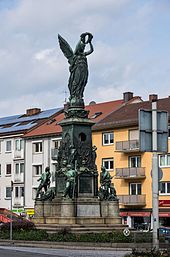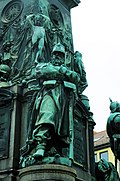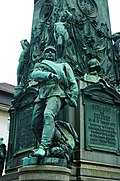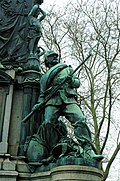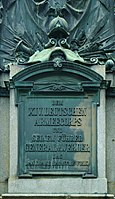Victory Monument (Freiburg im Breisgau)
The Victory Monument in Freiburg im Breisgau is a memorial that commemorates Germany's victory in the Franco-Prussian War in 1871. It was built on the northern edge of the old town in front of what was then the Karlskaserne and after the Second World War it was moved about 100 m to the west. In the course of the new construction of the "Rotteckring" light rail line, it was moved back to its old location in autumn 2017. The victory monument is now a listed building. The population also associates the Victory Monument with the transport hub, and the tram and bus stops there carried this name until the timetable change in spring 2019. Officially, the square, which was called “Wilhelm-Platz” or “Kaiser-Wilhelm-Platz” after 1877 and was nameless for many years, has officially been named Europaplatz since 2018 . The largest Christmas tree in town is traditionally located here during Advent and Christmas.
history

The victory memorial was dedicated to the XIV Army Corps , most of which were soldiers from Baden . Under the command of General August von Werder , the fighting at Montbéliard was victorious in 1871. Due to the general mood of victory, a fundraising campaign was carried out in Baden, more precisely from Lörrach to Karlsruhe , to set up the statue in the center of Baden.
In order to obtain a design, a public competition was announced among the sculptors in Germany, and some artists were explicitly invited to participate. The jury consisted of five performing artists and art connoisseurs:
- Ernst Hähnel from Dresden
- Wilhelm Lübke from Stuttgart
- Eduard Magnus from Berlin
- Friedrich Pecht court painter from Munich
- Gottfried Semper from Vienna
Among the eighteen applicants, the sculptor Karl Friedrich Moest , who worked at the art school in Karlsruhe, received the first prize, which consisted of transferring the execution. Professors Caspar von Zumbusch in Munich and Reinhold Begas in Berlin, whose models were placed in the municipal antiquities collection (today: Augustinermuseum ), took second and third place. Another second place went to the Freiburg sculptor Alois Knittel , whose son Gustav Adolf Knittel was later involved in the execution as a master student of Moest.
The artistic and ornamental jewelry, for its manufacture Emperor and Grand Duke a number of captured barrels leaving was in the fine art foundry of Christoph Lenz made in Nuremberg, while the granite work of the Freiburg masons Alberto Luratti were produced. The total cost was 85,000 marks .
The monument was inaugurated on October 3, 1876. Guests of honor at the inauguration were Kaiser Wilhelm I , Grand Duke Friedrich I of Baden with his wife, Grand Duchess Luise , Chancellor Otto von Bismarck and von Werder himself.
On the occasion of a metal collection campaign in 1940, Robert Wagner , Gauleiter of the NSDAP , asked for the monument to be given to Adolf Hitler for his birthday, but the city rejected this. The memorial survived the bombing raid on November 27, 1944 unscathed, although the Karlskaserne immediately next to it was completely destroyed. The west wing of the barracks, which was built in the 18th century, was rebuilt in 1950–51 and today houses the city's social welfare and youth welfare office.
In 1948, an application by the Peace Society and the Association of Military Service Opponents was rejected, the aim of which was to dismantle the monument. In connection with the construction of an inner city ring road, the monument proved to be a traffic obstacle in 1961 and was therefore moved about 100 m to the west. The memorial for the 3rd Badische Dragoon Regiment , which was dismantled after the war, was roughly there . Victoria was turned with a view of the former Karlskaserne. At the old location of the Victory Monument, a large intersection with tram and omnibus stops and pedestrian underpasses was created . In 2001 the local council decided on an urban space concept to redesign the Rotteckring up to the victory monument and the construction of a new urban railway line. Work began on January 15, 2015 and was largely completed by the end of 2018. In the spring of 2016, the victory monument was dismantled and stored in the municipal building yard before it was re-erected in autumn 2017 in front of the Karlskaserne, not far from its original location. As before, the goddess of victory Victoria was oriented towards Kaiser-Joseph-Straße.
After months of discussions since 2017, a majority in the local council emerged in mid-February 2018 to name the previously unnamed place Europaplatz . On March 20, a majority in the local council voted in favor. However, this proposal was not favored in the culture committee. There were previously suggestions for Friedensplatz or Platz des Friedens or Jean-Jaurès-Platz . Cultural Mayor Ulrich von Kirchbach was given 370 signatures for Friedensplatz by the "ini.platzname" initiative . The public inauguration of the square named Europaplatz took place in November 2018.
On February 20, 2018, the municipal council decided to insert three information boards (in German, English and French) into the ground directly at the monument. The German language text should read:
“Victory Monument from 1876
by Friedrich Moest (1838-1923)
Even before the end of the Franco-Prussian War in 1870/71, numerous Baden municipalities and civic associations initiated the erection of the victory memorial in Freiburg. They wanted to thank the XIV Army Corps, which had won the victory at Belfort over the French army under General August von Werder. Four simple soldiers symbolize the branches of service. Victoria, the goddess of victory standing on a globe, honors it with a laurel wreath. On October 3, 1876, the victory monument in front of the Karlskaserne was inaugurated in the presence of Kaiser Wilhelm I and Grand Duke Friedrich I of Baden.
In the course of the redesign of the Friedrichring and the square in 2017, there was a controversial discussion about whether such a monument could be erected again. It is an example of a time of armed conflict between nation states, which was overcome with the establishment of Franco-German friendship and the European Union.
In the end, the Freiburg municipal council voted by a majority for the monument to be located in front of the former Karlskaserne as a testimony to history and as a memorial against war and nationalism. The original elevation and shielding by a fence was deliberately omitted. The historic victory monument is intended to encourage us to permanently overcome nationalism and war and to work actively for peace and international understanding.
Therefore, in 2018, the municipal council named the square, originally named after Kaiser Wilhelm I, in ……… *.
Further information at: www.freiburg.de/siegesdenkmal "
The boards were installed in June 2019.
construction
Above the base substructure of the Black Forest - granite , from all sides leading up to the stage, a tapered upwards rises pedestal . This is crowned by a goddess of victory standing on a hemisphere with a laurel wreath in her raised hands. The rounded pedestals in front of the substructure around the corner carry four warrior figures of different branches of arms, three of which symbolize the defensive battle, while the fourth, an artilleryman , collapses deadly. The figures are considered to be the main work of Karl Friedrich Moest .
Four bronze plaques with inscriptions are set into the pedestal , while the corners are adorned with young geniuses of agitated demeanor:
Battle of BELFORT January 15, 16, 17, 1871. Siege of Strasbourg, Schlettstatt, Neubreisach, Belfort. Battles at Etival, the Ognon, Dijon, Pasques, Autun, Nuts, Langres, Vellefaux, Villersexel.
Telegram from Empress-Queen Auguste in Berlin. After three days of battle, Bourbaki has withdrawn from Werder's heroic resistance. Werder deserves the highest recognition and its brave troops. Versailles January 18, 1871 Wilhelm.
Above you can see the badges of the German Empire in medallions.
reception
"The whole thing is an excellently successful achievement that dominates the location to a large extent, even if the architecture appears a bit too soft and bluntly structured."
"With the defensive position of the four warrior figures on the projections at the four corners of the substructure, the artist describes the main character of that great fight, the task of which was not to proceed aggressively like the enemy, but to open the gate to the unprotected fatherland the last man to defend. Three German men have now been honored with monuments in Freiburg: Rotteck , Berthold Schwarz and Werder. "
literature
- Ingrid Conradi: Glitz and Gloria - or bad taste? In: Michael Klant (Ed.): Sculpture in Freiburg. Volume 2: 19th Century Art in Public Space . modo Verlag, Freiburg 2000, ISBN 3-922675-77-8 .
- Hans Schadek (Ed.): Freiburg then, yesterday, today. The city through the last 100 years . 2nd edition, Steinkopf, Kiel 2004, ISBN 3-7984-0771-1 .
- Ute Scherb: We get the monuments we deserve. Freiburg monuments in the 19th and 20th centuries. Freiburg 2005, ISBN 3-923272-31-6 .
- Friedrich Kempf: Public fountains and monuments . In: Baden Architects and Engineers Association, Upper Rhine District (Ed.): Freiburg im Breisgau. The city and its buildings . HM Poppen & Sohn, Freiburg im Breisgau 1898, p. 492-494 ( Scan - Wikisource ).
Individual evidence
- ↑ a b Resolution proposal for the Stadtbahn and redesign of Werhmannstrasse, Rotteckring- and Friedrichring , printed matter G-11/033, municipal council meeting on March 15, 2011, accessed on September 17, 2013, council information and citizen information system of the Freiburg im Breisgau city administration
- ↑ Joachim Röder: Europaplatz stop from spring 2019. Badische Zeitung, March 25, 2018, accessed on June 27, 2019 .
- ↑ Peter Kalchthaler: Freiburg: Series: Wiedersehen !: Siegesdenkmal is to return to its original location. In: Badische Zeitung. May 23, 2016. Retrieved May 24, 2016 .
- ↑ BZ editorial team: Christmas is getting closer. Badische Zeitung, November 20, 2018, accessed on November 20, 2018 .
- ↑ The models are no longer in the Augustinian Museum, but the design drawings by Karl Friedrich Moest (D 0148, D 0148 b and drawing G 2744).
- ^ Michael Klant: The artist family Knittel . In: Freiburg biographies. Promo-Verlag, Freiburg im Breisgau 2002, ISBN 3-923288-33-6 , pp. 173-180.
- ↑ Ulrich P. Ecker: The Destruction of Freiburg in World War II. In: Stadt Freiburg (Ed.): Freiburg 1944–1994. Destruction and rebuilding. Waldkirch 1994, ISBN 3-87885-293-2 , p. 18.
- ↑ Simone Höhl: Free path for the new tram line. In: Badische Zeitung. January 16, 2015, accessed June 23, 2015 .
- ^ Freiburg: Abundantly demolished monument. In: Badische Zeitung. April 5, 2016, accessed April 7, 2016 .
- ↑ Simone Höhl: Freiburg: The Victoria moves back into focus. In: Badische Zeitung. July 30, 2015, accessed April 7, 2016 .
- ↑ lit / si: RATS SPLITTER - Freiburg - Badische Zeitung. Badische Zeitung, July 27, 2017, accessed on July 27, 2017 .
- ^ Frank Zimmermann: Sharp debate about the victory monument - Freiburg - Badische Zeitung. Badische Zeitung, September 28, 2017, accessed on September 28, 2017 .
- ↑ Joachim Röderer: The place at the victory monument is now called Europaplatz - Freiburg - Badische Zeitung. Badische Zeitung, March 20, 2018, accessed on March 21, 2018 .
- ↑ Uwe Mauch: Europaplatz for the Victory Monument? - Freiburg - Badische Zeitung. Badische Zeitung, February 9, 2018, accessed on February 15, 2018 .
- ↑ BZ editorial team: Freiburg initiative calls for Friedensplatz at the victory monument - Freiburg - Badische Zeitung. Badische Zeitung, March 10, 2018, accessed on March 10, 2018 .
- ↑ Fabian Vögtle: "Hans im Glück" burger chain opens a branch in the pavilion at the Victory Monument. Badische Zeitung, November 23, 2018, accessed on March 13, 2019 .
- ↑ 2nd meeting of the municipal council: communication of results. Retrieved June 30, 2019 .
- ↑ Suggested text explanatory board for the Victory Monument. Retrieved June 30, 2019 .
- ↑ BZ editorial team: Three floor panels explain the victory monument. Badische Zeitung, June 28, 2019, accessed on June 27, 2019 .
- ^ Hermann Alexander Müller : Biographical Artist Lexicon. The most famous contemporaries in the field of fine arts of all countries with details of their works. Bibliographisches Institut, Leipzig 1882, p. 385 f.
- ^ Friedrich Kempf: Public fountains and monuments. In: Baden Architects and Engineers Association, Upper Rhine District (Ed.): Freiburg im Breisgau. The city and its buildings. HM Poppen & Sohn, Freiburg im Breisgau 1898, p. 494.
- ^ The Freiburg Victory Monument . In: The Gazebo . 1877, p. 716 ( full text [ Wikisource ]).
Web links
- The monument in 1890 and today
- Freiburg newspaper from the day of the unveiling
Coordinates: 47 ° 59 '53.51 " N , 7 ° 51' 5.08" E

